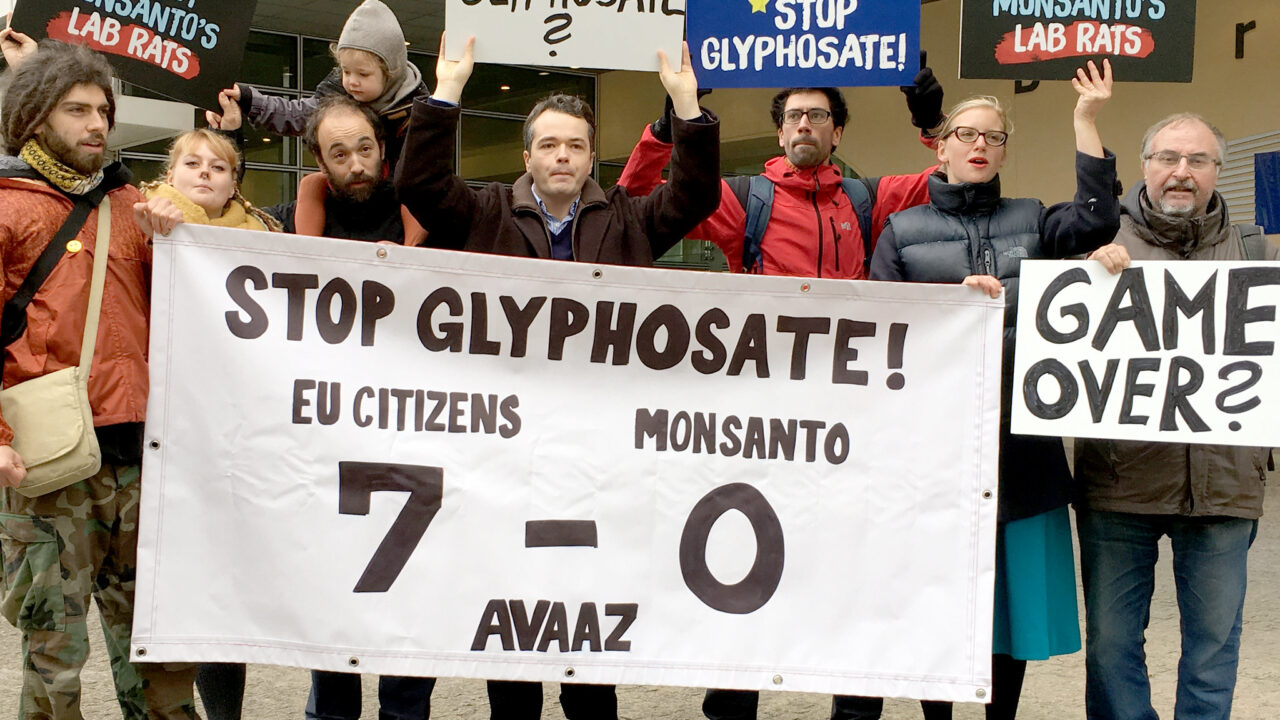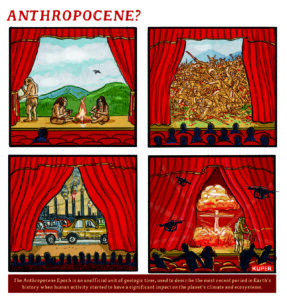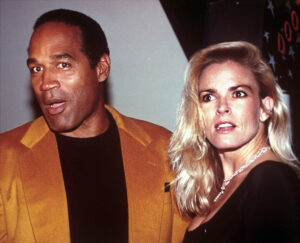Monsanto and the Battle Over Scientific Consensus
In “Glyphosate and the Swirl,” Vincanne Adams explores the history and debate surrounding a potent herbicide. Citizens celebrate yet another defeat for Monsanto in front of the European Commission. / Flickr
Citizens celebrate yet another defeat for Monsanto in front of the European Commission. / Flickr
Almost 90 percent of scientists believe that genetically modified foods are entirely safe. Yet, just 37 percent of the general public think these foods are safe to eat. Why are so few on board with the scientific consensus? Are they just anti-science?
In “Glyphosate and the Swirl: An Agroindustrial Chemical on the Move,” medical anthropologist Vincanne Adams deciphers competing claims about the history and epidemiological impact of glyphosate, the main ingredient in Roundup, the powerful herbicide patented by the agrochemical giant Monsanto that is commonly used to grow genetically modified foods. Depending on where you look for evidence, glyphosate either poses no harm to humans or is the root cause of a public health crisis. In the process of analyzing the uncertainty about glyphosate’s safety, Adams leverages the debate to interrogate what scientific consensus even means as a concept.
Even glyphosate’s origin story is contested, according to Adams, with one version crediting chemist Henri Martin with crafting the chemical in his laboratory in Switzerland in 1950. Glyphosate later made its way to Monsanto in the 1960s via a series of business acquisitions. In another telling, Monsanto scientist John Franz was working with several chemicals while trying to develop a water-softening product that could be repurposed as an herbicide. He found glyphosate to be particularly effective at killing plants by blocking a key metabolic process.
Monsanto began using glyphosate in the 1970s. Most herbicides at the time worked by creating a chemical barrier on the surface of the soil that killed weeds as they sprouted through. Roundup, however, is applied after weeds start to grow, and in contrast to other herbicides that selectively kill weeds but leave crops unharmed, farmers had to be careful with the indiscriminate effects of Roundup use.
Monsanto also began to invest in research on genetic engineering in agriculture and farming. Plants could be modified to ripen without softening, to have higher nutrient content, to resist frost, and to be tolerant to insects and viruses. Despite the company’s efforts to portray itself “as both defender of the environment and friend of farmers,” Adams writes, enhancements in nutrition, flavor, and size were marginal in its investment in genetically modified crops.
Over time, the proliferation of genetically modified crops has led to glyphosate being found in soils, water sources, air, food, and even breast milk and urine.
Instead, Monsanto focused on creating a genetic modification that would create plants that could withstand multiple applications of Roundup throughout the planting season. This enabled the company to make a fortune selling both seeds and herbicides, which farmers could spray with abandon. After introducing genetically modified soybeans to the American market in 1996, Monsanto launched Roundup Ready beets, corn, and cotton. Now, genetically engineered varieties comprise more than 90 percent of the major crops in the U.S.
Over time, the proliferation of genetically modified crops has led to glyphosate being found in soils, water sources, air, food, and even breast milk and urine, Adams writes. At the same time, ambiguities about the implications of glyphosate’s potency and pervasiveness have been the subject of a fierce, decades-long debate about chemicals and harm.
Adams characterizes this debate as “the swirl,” a condition in which certainty is continually contested, divided, and multiplied. This uncertainty is partly a function of the way glyphosate spreads unevenly in environments and bodies: Chemicals in foods are “digestive interlopers,” she writes, clustering and potentially damaging tissues and physiological systems throughout the body.
Adams recounts the stories of several patients who came to her through her neighbor Michelle Perro’s pediatric clinic. Perro (with whom Adams wrote the 2017 book “What’s Making Our Children Sick?”) worked with children struggling with severe chronic health problems that other doctors had been unable to explain or cure. She observed that after reducing glyphosate-rich foods from their diets, children with debilitating digestive problems saw their diarrhea, bloating, and constipation disappear.
While Perro claims to have identified and tried to treat what she thinks are glyphosate’s multiple effects, some of her colleagues have called her clinical ideas speculative, and even Adams acknowledges that she could not attribute the patients’ improvements to dietary changes alone, as opposed to pharmaceutical remedies. Nonetheless, she writes, “The facts and the clinical perceptions that Michelle brings to bear on behalf of her patients reveal an attunement to and a comfort with the perpetual motion of different formations of the swirl.”
The truth is, there is no scientific consensus, according to Adams. Evidence does not just accumulate. Rather, she notes, scientists, industry, and government weave evidence together and put data and findings from disparate studies into conversation with each other.
Adams looks at large reports and reviews on glyphosate, for example, which take results and data from many independent studies to get a robust view of the evidence. She compares two studies published in 2016, one a consensus report based on hundreds of peer-reviewed publications conducted by the National Academies of Sciences, Engineering, and Medicine, the other a review drawing from 80 publications and written by a team of environmental scientists, biologists, and medical researchers in the journal Environmental Health. The consensus report concludes that genetically engineered foods and pesticides are safe for human consumption, while the review article argues that scientific evidence shows that glyphosate poses serious health risks to humans and animals.
How is it possible that the studies came to such starkly different conclusions about the health risks of glyphosate?
It’s hard not to think about the current debates over masking, vaccination, and the long-term health risks of contracting Covid-19 while reading her account of scientific consensus
Adams argues that it’s not enough to simply locate where the preponderance of evidence lies. Drawing conclusions based on “data generated from a rat or mouse study here and a soil study there, an epidemiological study here and a livestock study there” is like comparing apples to oranges, she writes. By packaging evidence from different (and sometimes noncomparable) research together, she writes, these studies “erase the specific ways in which each study defines its limitations or leaves open questions of reading the evidence otherwise.”
That’s not to say the authors of the two studies misconstrued the facts. Rather, Adams highlights the inherent instability in scientific consensus around glyphosate. The uncertainty pulls readers deeper into the swirl.
Monsanto has funded agroscience departments and research institutes across the United States, and the agrochemical industry has blurred “the lines between reliable and biased science” in such a way that “makes it impossible to either discredit or believe the scientific consensus,” she concludes.
In the process, Adams draws a connection between how Monsanto — which was bought by the German pharmaceutical company Bayer in 2018 — has enlisted glyphosate in pursuit of profits and expanded agricultural outputs, and the ways activist networks have wielded the chemical to hold these actors accountable for harm, with mixed success.
The glyphosate debate with all its uncertainties “invites us to get comfortable with the movements of the swirl,” Adams writes, “from the cellular all the way to the grand social and infrastructural arrangements of capitalism, research, regulation, clinical care, and so on.”
It’s hard not to think about the current debates over masking, vaccination, and the long-term health risks of contracting Covid-19 while reading her account of scientific consensus. In fact, Adams sees the swirl as having “particular saliency in our times,” given that “the production of a scientific consensus about so many things seems to be so urgent and yet so persistently up for grabs.”
This article was originally published on Undark. Read the original article.
Your support matters…Independent journalism is under threat and overshadowed by heavily funded mainstream media.
You can help level the playing field. Become a member.
Your tax-deductible contribution keeps us digging beneath the headlines to give you thought-provoking, investigative reporting and analysis that unearths what's really happening- without compromise.
Give today to support our courageous, independent journalists.









You need to be a supporter to comment.
There are currently no responses to this article.
Be the first to respond.